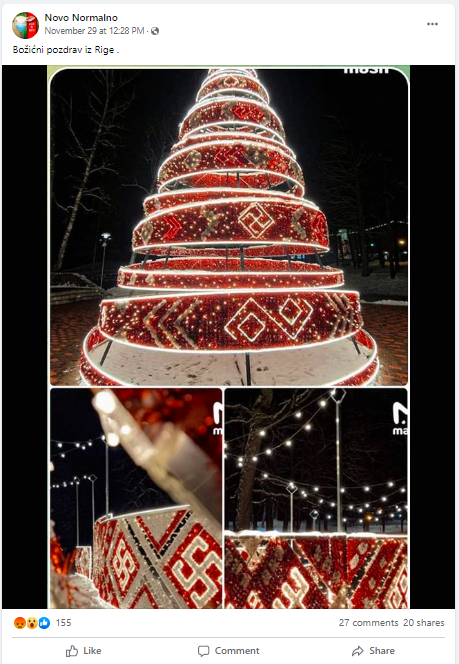Original article (in Bosnian) was published on 05/12/2022
The “fiery cross”, the Latvian version of the swastika, was part of the folklore of the people of Latvia for centuries before the swastika became a symbol of Nazi Germany. Its depiction on Christmas ornaments in this country has nothing to do with Nazism.
A collage of three photos was published on Facebook on November 29, 2022, showing Christmas trees and other decorations with symbols reminiscent of the Nazi swastika.

Although there is no claim in the post itself that the decorations are in the form of a Nazi symbol, it can be seen from the comments that Facebook users have interpreted the photos in the same way.

The post had more than 200 interactions at the time of writing this analysis.
What are the facts?
The Reuters fact-checking team analyzed similar posts of a photo of a Christmas tree in Latvia and insinuations that the decorations represent a Nazi symbol in an analysis published on November 30, 2022.
The Christmas tree in the photos was not placed in Riga, but in the city of Lielvārde, 55 kilometres away from the capital of Latvia. There are decorations on the Christmas tree that resemble a swastika – but it is not a symbol of Nazi Germany. It is a symbol that in Latvia is called ugunskrusts – or “fiery cross” – and is rooted in the country’s history and folklore.
The National Encyclopedia of the Latvian Ministry of Culture explains that this symbol pervades Latvian mythology, although today it can be interpreted as controversial due to Nazi connotations.
On the territory of Latvia, the oldest sites of the “fiery cross” date back to the 3rd century. In the following centuries, the “fiery cross” could be found in the archaeological material of all ethnic groups living on the territory of Latvia – lībiešu, kūrsu, zemgaļu, sēļu and latgaļu.
The site explains that there are multiple variations of this symbol, including ones that look just like the Nazi swastika. The Latvian version of the swastika was used as a military symbol from 1915 on the flag of the Second Riga Rifle Battalion or as the insignia of the Latvian Air Force from December 1919 to October 1940. However, the symbol was also used by Latvian Nazi sympathizers in the 20th century.
It adds, however, that the use of Nazi swastikas is illegal in Latvia. The symbol is allowed only if “the purpose of the use is not related to the glorification of totalitarian regimes or the justification of committed crimes”.
This law does not affect cases when the “fiery cross” is used in the context of folk ornament… dance festivals, folk art products or in other creative ways.
Although mostly associated with Nazi Germany, the swastika, as a symbol of prosperity and good luck, is widespread in the ancient and modern world. As stated in the Encyclopedia Britannica, it is a symbol that was widely represented on coinage in Mesopotamia, appears in early Christian and Byzantine art, in Scandinavia, and the use of the swastika was recorded in Central and South America among the Maya and in North America, in Navajo Indian tribe.
We wrote about the use of the swastika as a military symbol in the analysis in which we dealt with the identification of the Finnish swastika with the symbol of Nazism.
https://raskrinkavanje.ba/analiza/svastika-na-zastavama-finskog-vazduhoplovstva-nema-veze-s-nacizmom
As in the case of the Christmas tree from Latvia, the story about the “Nazi symbols” on the flags of the Finnish army was published in the context of the Russian invasion of Ukraine, which Vladimir Putin justified with the goal of “denazification” of that country. Examples of “Nazism” from other countries in Russia’s neighbourhood should provide additional support for such a justification.
Since there are no Nazi swastikas on the Christmas tree from Latvia, a Facebook post insinuating that this is the case is rated as the manipulation of facts.



